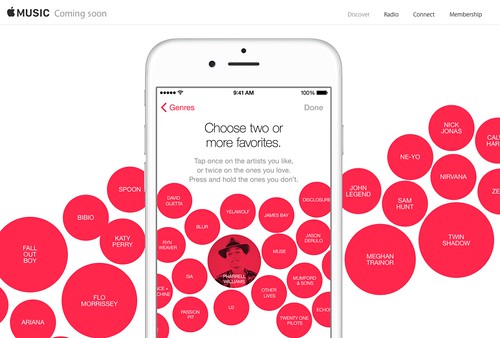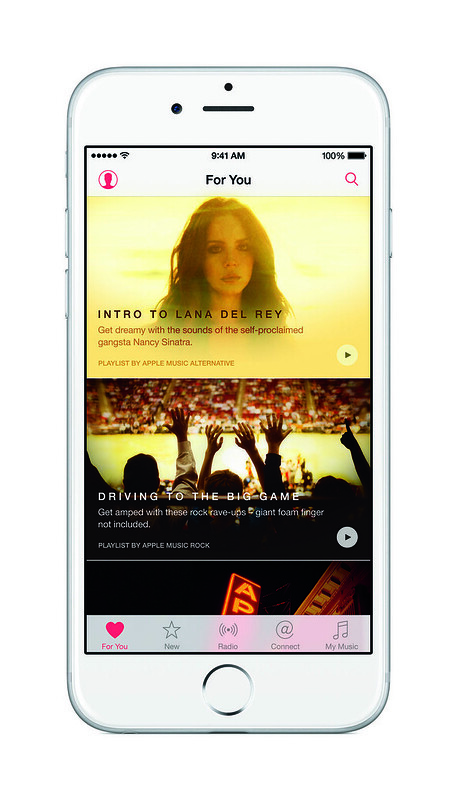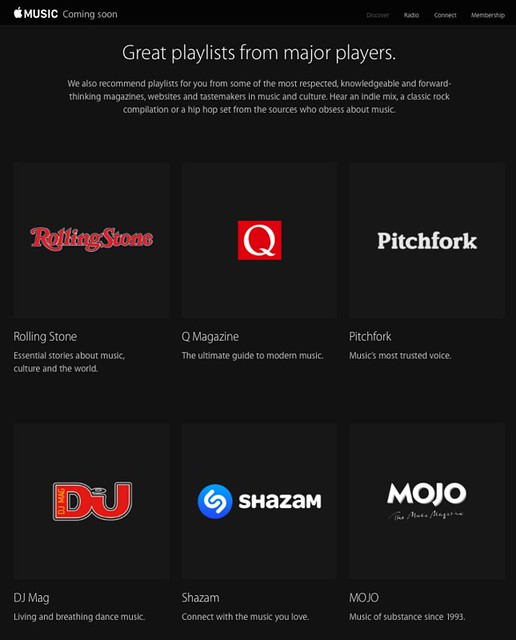For the past 20 minutes I have prodded, flicked and tap-tapped on the screen of an iPhone 6 Plus. This screen-poking was done whilst being walked through Apple's much talked about Apple Music service, which launches in less than 24 hours. The launch is reported to be around 4pm BST on Tues June 30th when their latest software update (iOS 8.4) is pushed to all. Zane Lowe has also confirmed he’s going on air on their Beats 1 radio station shortly after this time:
If you don’t know what I’m talking about, you also probably don’t know who Taylor Swift is and think Tinder is something you use to start fires. In essence, what 'everyone' is talking about is the fact that the people who make MacBooks, iPhones, iTunes and iPhones, are about to launch their own streaming service named Apple Music.
What’s a music streaming service? Of course you know, but if - like millions of people - you’ve never used Spotify or RDIO, Deezer, Tidal, GooglePlay, AmazonPrimeMusic, we7, or NapsterToGo, think of it as a seemingly infinite jukebox. You can press play on songs, in much the same way you do with videos on YouTube or the iPlayer, the music plays.
Unlike iTunes, there's no purchase necessary because you're a subscriber to the music streaming service (or in some cases, but not in Apple's, because there's advertising). On music streaming services you can make playlists (think: mixtape compilations of songs you like) and you can also save music offline to listen to when you’re not on the internet (think: 63% of your train journeys when the 3G disappears) (think: that corner of your house where the wireless sometimes stops working at 1:32pm on a Sunday for 2 minutes). If you need an analogy: it’s an all you can eat buffet for music, only with your ears bloating rather than your thighs and belly.
Following some wrangling with record labels, Apple Music will launch tomorrow with a three-month free trial. They will be paying all the musicians and their record companies tiny bits of a penny every time you listen to a song. Then, once your trial runs out it will cost $9.99 a month (or $15 a month for a family subscription) (we don’t know for certain exactly what the UK price will be) to continue streaming as much music as you like, whenever you like, wherever you like, on whatever Apple device you have handy. It will also work on PCs, however Android Phone users will need to wait until “the fall” (that’s autumn to you non-American oiks!).
For many of us, music streaming has been around for a decade or so. I’ve tried almost every service since Napster went legit, and have been using Spotify since the early days - I’ve even been a user of Tidal until recently (despite the reaction to their launch video, it’s alright actually). I've seen the rest, and today was my chance to see what one of the biggest companies in the world, having bought Beats and its streaming service a year ago have in store for music lovers.
Beats fka Beats by Dre, make those big headphones you see footballers and urban youth/commuters wearing. They also had, until recently the Beats Music streaming/subscription service. As part of the $3 billion deal, Apple kept the Beats Electronics team, which includes major label industry moguls, legendary hip-hop artist/producer Dr Dre, Trent Reznor from Nine Inch Nails, and the smart guys behind Topspin, who revolutionised selling music directly to fans.
A few hours ago, I was given a 20 minute preview of the software on the eve of Apple Music’s launch. Here’s what I glimpsed and garnered from it in an iPhone 6 Plus…
Setting It Up
First up, the Music logo in the bottom right-hand corner of the iPhone has been redesigned with a little rainbow of colour which will no doubt excite design geeks. This quickly got clicked and up popped the app.

You sign in with your iCloud account (which are free to create if you don’t have one). Then, when first loading the app, you’re given a series of bubbles to tap on. Each wobbly orb features genres or artists you might like (see above). Tapping once makes the bubble bigger to say you like them a bit, tapping twice makes the bubble even bigger to say you like them a lot. You can also hold down the button to get rid of stuff you don’t like (bye bye Calvin Harris!). As the bubbles change size, more acts come in to view. Interestingly, it didn’t take long for lesser known acts like LA Priest to start sneaking into the bath of names.
This first screen, which is purely there to begin your personalisation of the app was reminiscent of ye olde music-map.com, which way back in the early 00s was one of the first data projects we remember that visualised the recommendation engine by clustering the most similar artists together in little constellations. It's a nice little nod to digital music's past, whilst also still being one of the best ways of making sense of how an algorithm works to non-tech types.

For You
Once you’re done with the bubbles, and whenever you open the app, this personalised "For You" section will be the first thing you see. Its reason for being is seemingly to get over so-called "choice paralysis" aka that empty headed ‘what should I listen to now?’ feeling.
In this section, Apple Music will present playlists featuring some music you like, and introductions to acts you might be into.
Because I double-tapped on the Paramore and EMO bubbles, the top of my “For You” section had a playlist introducing me to the band Say Anything (who surprisingly I haven’t ever listened to…). There was also an Emo playlist, and one with GreenDay's best songs. These playlists have been compiled by their team of experts - although it doesn’t say who these humans are, but they assured me these selections weren't made by algorithms. The specialists compiling all of the playlists I saw in "For You" are currently all in-house Apple employees, rather than friends, musicians or some of the external curators who’ve made playlists. Shazam, Pitchfork and other launch curators mentioned in the keynote launch (listed below) feature under a separate tab further down the page, but my guess is that they might appear more prominently at some point further down the line. You can however subscribe to these curators and follow genres, which will give you alerts when new playlists are posted.

Whilst we’re talking about playlists, one thing they did mention was that - unlike most other streaming services - your personal playlists are private unless you're an Apple-affiliated curator. This perhaps isn’t such a big deal if most of your Spotify playlists only have 4 followers…
Scrolling further down the "For You" section there were albums by a range of acts including some band called Radiohead. Below that there was more stuff but we whizzed on to the next section.
New
This is a much nicer looking version of the sorts of albums and tracks you see to the fore of the current iTunes store. There were big new releases, including Florence + The Machine, The Who, and that brilliant debut album from Wolf Alice in the top slider. Further down the page there are charts of the most streamed songs, albums and videos (oh yes, video features in the mix!). Beneath that there were “Hot Tracks” featuring a mixture of hand-picked new additions and stuff currently being bigged up on the internet.
Radio
The next section on the menu along the bottom of the Apple Music screen is “Radio”. In here there was a massive image for the launch of Beats 1, which is their much-hyped 24-7 online radio station featuring ex-Radio 1 DJ Zane Lowe based out in LA, alongside presenters Ebro Darden in New York, and from Rinse FM Julie Adenuga in London. There will also be special shows on Beats 1 from guest musicians, and we hear from reports that St Vincent and Elton John will be in the mix, if you 'keep it locked'.
Aside from Beats 1, there were also genre-based and mood-themed stations. You can also create a station based on acts you like. This is slightly different to playlists, but sort of similar.
Connect
Connect is a stream of updates from musicians that you follow. Artists will get a slightly different version of the Apple Music app so that they can update their profile with videos and photos or share tracks/albums with their fans. You can comment, although you’re probably best not to write ‘COME TO CHILE’ or ‘NOTICE ME QUEEN!!!!!’ if you actually want a response from Lady Gaga.
A quick scroll through this feed revealed Alabama Shakes in session, a video message from Enrique Iglesias, and Trent Reznor sharing links to streams. I believe this semi-random selection was due to the acts the demonstrator had already followed, rather than a default list of acts.
One thing the demonstrator did mention was that after the free trial, artists won't need to pay for Apple Music to update their account, which is good news for all of you vinyl savant musicians who begrudgingly update social media when you have a new album out, but who don't want to or can't afford to spend $120 a year on music streaming. Musicians wanting to get their Connect account set-up can do so by registering here.
My Music
This looks much like your iTunes that you’d recognise on a smartphone with all of your purchased tracks and music you’ve imported from iTunes. When you click play a mini player appears at the foot of the screen. You also can click on the track to add it to a playlist or browse for more music by that artist. Sadly it doesn’t look like you can easily find out more about the tracks, like what label it’s on or who produced it or the lyrics or how many songwriters it took to write a Beck vs Beyonce song... but then you do have the entire internet at your disposal if this is of interest.
The DiS Verdict
With anything Apple do you have to prepare yourself to either be blown away or nod approvingly. As a nerd, despite your biggest hopes, you never truly expect to see the future and feel things revolutionised. No matter how many times a presentation calls something a "revolutionary music service" it's a hard thing to really re-invent the presentation of songs to listen to.
For all the hype, there are still personalized recommendations that will only be as good as you tweak them. There are still charts presenting the most popular music. And there's still a chance that most artists will carry on using Instagram or Facebook or email or whatever they're in the habit of flicking open to communicate with their fans, rather than try to transition their audience over to another service.
Apple have once again improved upon what already exists, and make it friendlier for mass consumers. Much like iTunes was the far more graceful version of Mp3.com and Vitaminic; or the iPod was a far smarter version of the MiniDisc (which I filled with MP3s from Napster), Discman’s which played data CDRs or those original RIO hard drives which played music files; Apple Music feels like a smarter streaming service, but it doesn’t do anything you haven’t seen before.
Apple Music has personalized recommendations in For You, which is a bit Last.fm meets iTunes’ Genius functions. It has Radio, which has been around forever, but not in your hand (unless you’ve previously used apps like iPlayer Radio or TuneIn), with some Pandora-style genre stations and some hack-du-jour in the form of a running-related reactive playlist (do that many people really jog...? Where's the breathalizer app that plays the perfect tune for how drunk you are...?). Then there’s Connect which is a far nicer looking version of iTunes’ short-lived Ping, which you can scroll through on your phone much-like you can with Twitter (and their short-lived Twitter Music app), to see the latest updates, videos, track recommendations and photos from your favourite acts.
So it still has charts, featured releases, and your “cloud” of ripped/purchased music, which definitely revolutionises iTunes. Revolutionising the biggest music service in the world, which revolutionised the music industry, now that - I concede - is revolutionary.
What it does best is what Apple always does best: it makes sense to bring all of these things together in one app - that's the clever bit.
Plus you get Taylor Swift’s 1989 and Dre’s The Chronic, which aren’t on any other streaming services, so what more do you want? (I didn’t have the heart to ask if it would have The Beatles…) There’s still plenty to come like Sonos integration and any music hardware products from Beats (although of course you can use headphones and bluetooth speakers).
Conclusion
We only saw it for twenty minutes, so it’s hard to tell for certain what it is really like to use. Sadly, there wasn’t any big ooh-ahh firework moment when something truly original or previously unannounced appeared.
What it is, is a very clear, familiar, and easy to navigate interface to encourage you to explore all the music you could ever want to hear. It will revolutionise the music business because it’s in everyone’s pockets, on their laps and resting on their desks, not because it does something ground-breaking with tech that presents music in a way that will impress a few thousand people for an afternoon, and bemuse everyone else. And yes, to use that iconic slogan: “it just works”.
For more details visit apple.com/music.
Related read: Return of the Mac: Our pre-announcement predictions of what we hoped Apple Music might involve.























